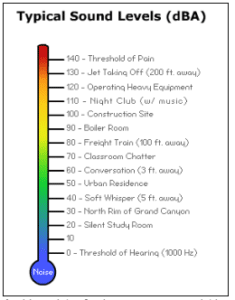
16 Jan What can be done to reduce the hazard from noise?
Hearing loss is one of the most common disabilities in the United States, strictly, because there are no warning signs.
According to the Occupational Safety and Health Administration (OSHA), 30 million workers experience hazardous noise while on the job, an estimated $242 million is spent annually on workers’ compensation for hearing loss disability, and hearing impairment costs the government billions of dollars on social security disability and Workers’ Compensation settlements.
The fact is, practicing workplace hearing safety can help to prevent these issues.
Your Exposure to Noise
Each day, we experience a wide array of sounds ranging from pleasant to annoying; radio, birds chirping, ambulance sirens, dogs barking, among many others.
Your work environment can also pose potential hazards to your hearing. “An employee may be exposed to work-related noise 8 hours a day, 40 hours a week, for a 40-year career.”
Hearing loss caused by exposure to hazardous noise occurs gradually, over time. While you cannot go back in time to put preventive actions in place to change your exposure to hazardous noise, you can take action, which will, in fact, make a difference right now.
Hearing Loss is Preventable
Noise-induced hearing loss is 100% preventable. “The choices you make today affect the quality of your hearing in the future.”
You should train yourself and your team to always use engineering controls to eliminate or reduce your exposure to high noise levels and wear the proper personal protective equipment when exposed to excessive noise, both on and off the job.
In addition, it is important to provide sound level monitoring, hearing tests, hearing protection devices, and training on hearing protection devices, audiometric testing, and effects of noise.
Workplace Hearing Safety Tips
Follow, but do not limit yourself to, these 5 tips to create a successful hearing loss prevention program:
- Minimize your exposure to loud noises that are persistent.
- Wear earplugs or protective earmuffs during any activity that exposes you to noise at or above 85 decibels.
- Take control of your hearing in the workplace by practicing workplace safety and monitoring your exposure to hazardous noises.
- Educate employees on the effects of noise, the section, fit and care of hearing protectors and the purpose of audiometric testing.
- Create a hearing loss prevention program and require periodic evaluation to assure its effectiveness.
For more safety resources that cater to your exact line of business, Synergy Comp partnered with an online training resource, Safety National.
Synergy Comp’s Free Safety Resources
Safety National is an online training resource that improves the safety performance of your whole team while building a culture of safety. The online training resource covers a broad range of topics related to your business including the topic, Hearing Safety.
After completing the lesson, will learn about the importance of taking proactive measures, both on and off the job, to prevent hearing loss. You should be able to:
- Explain how noise-induced hearing loss occurs and how it can be prevented.
- List engineering controls that can be used to reduce high levels of noise.
- Describe the main components of a Hearing Conservation Program.
Synergy offers several other safety resources to all current active clients that focus on the specific changes and challenges that are unique to all businesses. The pieces of training are industry-specific and cater to your exact line of business. The online resource will be free of charge; not only saving time but money.
If you are interested in partnering with Synergy Comp and SOS Safety Solutions to create a culture that fosters communication and embraces safety as a core operating principle, Contact Us Today!






No Comments